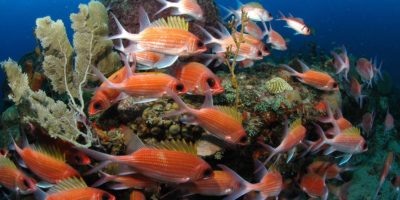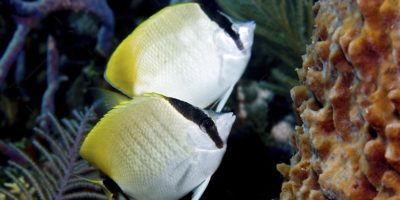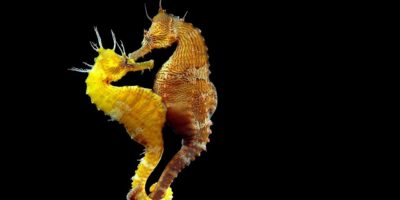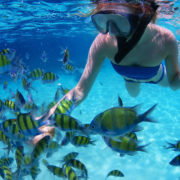French angelfish (Pomacanthus paru) is considered one of the most beautiful fish in the Caribbean, a favorite for diving tours. They belong to the order Perciformes, and have an oval shaped body with large trailing dorsal and anal fins that include a bright yellow margin and filament. They are harder to spot head on, but very easy to see on the side.
They are generally dark to black with their body scales edged in bright yellow, with yellow on their pectoral fins, also around their mouths and eyes. The juveniles are darker, and spot yellow bands that fade with age; also rounded fins that square and get pointed as they get older. French angelfish are monogamous, and stay with the same partner for life.
Photo Gallery
Size & Weight
French angelfish can reach a maximum length of 24 inches ( 61 cm ) but they are more common at lengths of 16 inches (40 cm). They can live up to 10 years and reach sexual maturity at lengths of 10 inches (25 cm).
Distribution & Habitat
The French angelfish is found in the Western Atlantic Ocean, all the way from the Bahamas, down to South Brazil. It is also found in the Gulf of Mexico and the Caribbean Sea, including the Antilles (Cuba and the Dominican Republic). It was recently introduced to the waters around Bermuda.
It is usually found at depths less than 15 feet ( 4.5 m) in coral reefs that offer protection from nocturnal predators. It is a very territorial fish, also curious and does not fear divers and snorkelers. In Sosua, a good place to find them easily is the Zingara wreck, at 150 ft depth.
Feeding Habits
Pomacanthus paru primarily feed on sponges as well as tunicates, zoanthids, corals, gorgonians, and algae. Vase sponges often show v-shaped scars from past angelfish bites. Juveniles feed on algae and detritus along with ectoparasites they clean from other fishes ( such as jacks, snappers, morays, grunts, surgeonfishes, and wrasses ).
On Video
Reproduction
Spawning of this species occur from April to September. During each spawning event, approximately 25,000-75,000 eggs are released. This activity is then repeated. The pelagic eggs are spherical and transparent with a diameter of 0.9mm. Eggs hatch approximately 15-20 hours after fertilization. The larvae live among plankton until they reach approximately 15mm where upon they settle onto the coral reef.























